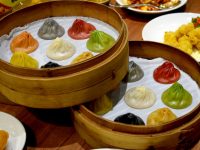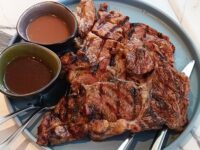 We were cruising the supermarkets last weekend when I saw that Canola oil was on sale. I’ve heard mixed things about canola oil – some say it’s healthy and good for you, some say it’s bad for you. If you read my blog, it’s obvious that I’m not a health nut and I’m not overly concerned with “good” or “bad” food. I just try to avoid the downright poisonous and really bad stuff. And I’ve been told that you need to use canola oil when making chiffon cakes. I’ve bought a liter or two over the years to use for baking and to try some recipes for making home-made mayo and salad dressings. I couldn’t decide if I wanted to buy the canola oil on sale and just let it be.
We were cruising the supermarkets last weekend when I saw that Canola oil was on sale. I’ve heard mixed things about canola oil – some say it’s healthy and good for you, some say it’s bad for you. If you read my blog, it’s obvious that I’m not a health nut and I’m not overly concerned with “good” or “bad” food. I just try to avoid the downright poisonous and really bad stuff. And I’ve been told that you need to use canola oil when making chiffon cakes. I’ve bought a liter or two over the years to use for baking and to try some recipes for making home-made mayo and salad dressings. I couldn’t decide if I wanted to buy the canola oil on sale and just let it be.
But after seeing the Canola oil on sale, it was nagging at me. Once and for all, I should find out if it’s good or bad, so I’ll know whether to rejoice (or not) when I see it on sale!
After reading the Canola wikipedia entry, I came to the conclusion that NO, I don’t want to use canola oil for any food I make, not anymore. Here’s some of the info that just leapt out at me:
- what we know as canola oil today is extracted from a low erucic rapeseed plant variety that was bred at the University of Manitoba in the 1970s
- the name “canola” was chosen by the board of the Rapeseed Association of Canada in the 1970s, the “Can” part stands for Canada and “ola” refers to oil.
- although rapeseed oil has been documented to have been used as old as 4,000 years ago, it was mainly used for fuel, like for oil lamps! NOT for human consumption!
- during the Industrial revolution (when they started making machines and factories sprung up), they used rapeseed oil as a machine/ engine lubricant!
- feed meal from rapeseed plant is not appealing to livestock (animals don’t like to eat it)
- a variety developed in 1998 is considered to be the most disease- and drought-resistant canola variety to date; this and other recent varieties have been produced using genetic engineering; in 2011, 26% of the acres sown were genetically modified (biotech) canola
Good lord, why are they still allowing this stuff to be sold as food?
To summarize:
- rapeseed oil was never really used as a food-grade oil by ancient civilizations – I’m sure those people experienced a lot of famine and scarcity, yet they never even considered rapeseed oil for food… makes you go hmmmm
- it was mainly used for fuel (oil lamps) and industrial applications
- they had to come up with a new name so people wouldn’t know what it really was – before reading up on it, I had no idea where canola oil came from… I would have guessed: canola plant?
- much of it now comes from genetically modified rapeseed
- it is extracted using hexanes – what are hexanes? glad you asked. it is basically what makes up gasoline; it is also used a lot in making glue for shoes, leather, roofing, etc.. it is toxic; too much exposure can cause hexane poisoning; do you really want these chemicals as a main component in processing the oil you are going to cook with?
Okay, I think I’ve read enough. The “good” and “healthy” things they say about canola won’t make up for the “eeek” factor. Sure, it contains omega-6 and omega-3 fatty acids. But would you really eat something ancient people didn’t eat, even though now it’s supposedly been cleaned up to make it fit for human consumption?
And the phrase “fit for human consumption” doesn’t really inspire a lot of confidence. Heck, according to standards, even poison is fit for human consumption if it’s diluted to a low enough dosage.
With all the confusing health information coming out, I don’t even know what to believe anymore. So I’m just sticking to the tried & tested route – if ancient people ate it, if people from a century ago ate it, if my grandparents’ generation can recognize it, I’ll eat it. Well, for the most part 🙂 Sometimes some sales and some food are just too good to pass up. But yeah, I try to eat “real food” vs. “fake food” as much as I can.
As for oils, I think we’re sticking with coconut oil, palm oil, olive oil, peanut oil, and butter. The good ones are a bit more expensive, and we can’t always get the good stuff, but WE WILL take advantage when they’re on sale 🙂 I think being able to get the good stuff once in a while is better than none at all. And obviously we should avoid the really bad stuff.
After reading all about canola oil, you can bet we’re never buying that again.
Do you have any suggestions for a “good” oil that is locally available and affordable? I mean for regular cooking like frying fish and chicken. I normally use olive oil for pasta sauces, and butter for vegetables but I don’t think olive oil will work for frying fish or chicken (and it will be too expensive)! We usually just use palm oil or corn oil from the supermarket. They’re probably bad too but hopefully not as bad as canola.
References:
Stop Using Canola Oil Immediately!
Canola Oil: There is the Good, the Bad and the Ugly















2 responses to “We’re Going to Stop Using Canola Oil”
I once drove myself crazy with this oil business. I read that I can’t use EVOO for cooking because of the low smoke point. Pure olive oil nalang. Ay kaso that’s a misnomer – they’re not using pure olive oil, baka they just mix several cheap oils in there. No to coconut oil because of the saturated fat. But wait – it’s kind of fat is good naman. Oh no, it’s not (WebMD). And vegetable oils are more harmful than trans fats (Mercola). Then there’s the canola controversy. Nose bleed. 🙁
But I love your site, so informative. 🙂
Hi Amelie! Thanks for dropping by!
We’d all drive ourselves crazy if we really thought about all the “bad” stuff that is in our food. Yes, I heard about “pure” olive oil being adulterated with a mix of several oils then they just put the olive oil “flavoring” or smell. Have you heard of the gutter oil scandal in Taiwan? It’s enough to make one paranoid about everything!
About EVOO, I think, generally, it’s not used for frying. Sayang kasi. EVOO is very fragrant. It’s from the first-press of the olive. Meaning no chemicals were used to extract the oil, just pressure. It’s also why it’s more expensive. If you use EVOO for frying, not only do you have a low smoke point, you also lose the fragrance. EVOO is usually used for making salad dressing and similar types of food where you need fragrant oil and don’t need to use really high heat. I also like using EVOO for making home-made pesto, and for adding to pasta in case the pasta is dry (kulang sa pasta sauce). You can also use EVOO for making dips (like sa Italianni’s – olive oil & balsamic dip for the bread). My favorite is actually to just finely dice some tomatoes, onions, garlic, add some rosemary and EVOO, and let the flavors develop in the ref for about a day – it makes a delicious dip or topping for toasted bread or crackers!
Coconut oil is good AGAIN daw. They keep changing their minds about what is good and what is bad. One time we got a small bottle of natural coconut oil, pasalubong from someone from one of those beach places, can’t remember which if Batangas, Puerto Galera, ???. Wow. It was really good! It smells coconut-y sweet, parang kakanin! As far as I can tell, they made it the traditional way and just let the coconut oil separate from the gata somehow. I haven’t come across this kind of coconut oil again, unfortunately…
It’s really a sad state of affairs when we can’t even trust that the products we buy are what they claim to be. The only thing we can do is to use our best judgement.
Thank you again for visiting! I’m so glad you enjoyed my blog 🙂